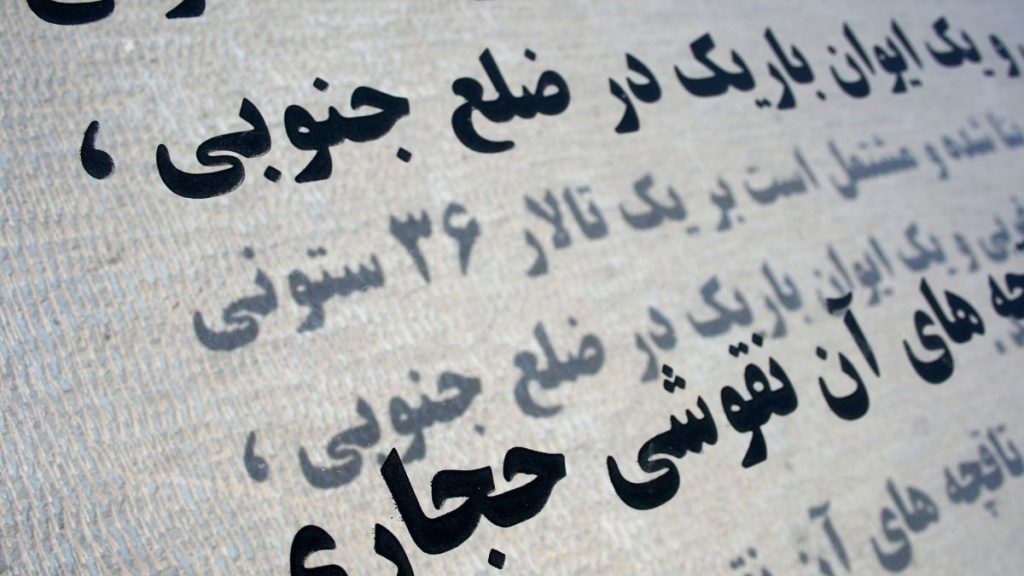If you’re interested in learning the Farsi (also known as Persian) language then you may want to know a little bit more about it before starting.
This post will cover if it is hard to learn Farsi as an English speaker and the similarities/differences between English and Farsi.
It will also answer how long it takes to learn Farsi.
Table of Contents
Is Farsi Hard To Learn?

Language Families
Farsi (also known as Persian) is an Indo-European language. Specifically it’s from the Indo-Iranian branch of this family.
English is also part of the Indo-European language family which means it has lots of similarities with other languages that fall within that family, including Farsi.
English falls under the Germanic branch of this family.
- Indo-European -> Indo-Iranian -> Farsi
- Indo-European -> Germanic -> English
These language families group together languages that descend from a common ancestral language.
In this case, both English and Farsi evolved from ‘Proto-Indo-European’, an ancient language that is thought to have been spoken 5000 – 6000 years ago.
Learning languages from the same language family tends to be easier as these languages share many similar characteristics with one another.
However, learning languages that fall within the same branch are even easier as they share more similarities.
English is more closely related to languages that fall under the Germanic branch of the Indo-European family which include German and Dutch.
The similarities vary between languages but can include vocabulary, word order, grammar, pronunciation and word composition.
This means that as both Farsi and English are part of the Indo-European language family, there will be many similarities between them. This will make learning the language much easier.
This doesn’t necessarily mean that Farsi will be easy to learn as it still falls within a separate branch of the family and has many differences to English.
It would be much easier for a native English speaker to learn Farsi than other languages that are not in the Indo-European family such as Mandarin Chinese, Korean, Japanese etc.
However it will be harder to learn Farsi than learning Romance languages such as French, Spanish, Italian, Portuguese or other Germanic languages such as Dutch and German.
Farsi will also be easier to learn than Slavic languages like Polish as it lacks the complicated cases.
It’s worth noting that if you already know another language that falls under the Indo-Iranian branch of the family, you will find learning Farsi much easier. Examples include Hindi, Urdu, Bengali, Pashto or Kurdish.
Lack of Resources
One barrier that will make learning Farsi harder than some other languages is the lack of resources.
Whilst there are quite a few courses out there that teach Farsi to English speakers, there are a lot less available compared with other more ‘popular’ languages like French and Spanish.
Even some of the most popular language learning programmes such as Duolingo do not have a Farsi course. Unfortunately Babbel doesn’t either.
This would also apply to forums and reference websites.
For example, if you have a question or are confused about something quite specific it may be harder to find the answer especially if you don’t know any native Farsi speakers.
One great resource for Farsi is our free 100 most common words in Farsi PDF. Grab yours below…
Pimsleur also has a really good Farsi course that will get you speaking from day one.
If you’re serious about learning Farsi, I’d recommend doing the Pimsleur 7 day FREE trial for Farsi.
How Long Does It Take To Learn Farsi For An English Speaker?

On average, it would take about 1100 hours or 44 weeks to learn Farsi for an English speaker.
This assumes you do 25 hours of studying a week. If you’re not able to dedicate this much time to learning Farsi it may take you longer.
This is based on the language classification system created by the Foreign Service Institute.
The Foreign Service Institute has several language categories that categorize how long it takes for a student to reach ‘professional working proficiency’ in a language.
They have put Farsi into category III which they describe as ‘hard languages’ or ‘languages with significant linguistic and/or cultural differences from English’.
Other languages that fall into this category include Russian, Greek, Polish, Turkish and many more.
1100 hours or 44 weeks is the average time that it takes students to learn to speak Farsi however this can vary depending on many factors.
Your progress may actually be much faster if you already speak a similar language such as Kurdish, Pashto, Urdu or Hindi.
Already speak Arabic? Found out if it is easy for Arabic speakers to learn Farsi.
Is English Similar To Farsi?

Whilst there are many differences between English and Farsi, there are actually more similarities than you might think.
Many of the similarities are quite distant as the 2 languages belong to separate sub-families of the Indo-European family which diverged quite some time ago.
Similarities
Loan Words
Due to the fact that Farsi and English are both from the same language family (meaning they evolved from the same language) there are actually some words that are similar/the same.
Here’s a few examples:
- Daughter – Dokhtar دختر
- Better – Behtar بهتر
- Bad – Bad بد
- Mother – Madar مادر
- Name – Nam نام
- Door – Dar در
- Thunder – Tondar تندر
Genders
You’ll be happy to know that words do not have grammatical gender in Farsi. English also doesn’t have grammatical gender.
If you’ve studied Spanish or French before you’ll know all about gender.
Each noun will be either masculine or feminine (or neuter in some other languages like Polish).
This can be tricky for English speakers but luckily you won’t have to worry about it with Farsi.
Tenses
One feature of most Indo-European languages is that they tend to have many verb tenses e.g. past, present, future, conditional etc. English and Farsi both have multiple tenses.
This feature isn’t present in many other types of languages, for example, Mandarin Chinese doesn’t have any verb tenses and Arabic just has 2 tenses.
Differences
There are also many differences between the languages.
Script
English is written using the Latin script, many other languages use this script including French, Spanish, German, Italian and more.
Farsi however is written using the Persian script which was developed from the Arabic script.
Here’s an example of the Persian script:
داشتم، میرفتم، دیدم، گرفته، نشسته، گفتم، بذار، بپرسم، ببینم، میآد، نمیآد، دیدم، میگه، نمیخوام، بیام، میخوام، برم، بگیرم، بخوابم
The scripts are very different and it often takes Farsi learners a lot of time to learn and be able to read the Persian script with ease.
Another difficulty is that the Persian script is written from right to left. This is different to English which is written from left to right. It may take a bit of time to get used to this.
Find out why Farsi uses the Arabic script.
Grammar
Grammatically, Farsi is somewhat different to English. For example, phrases will often have a completely different word order to what they would be in English.
In English, we would say ‘how are you?’. In Farsi, this phrase is حال شما چطور است (hal-e shoma chetur ast) which would literally translate to ‘condition of you how is?’.
However once you do get the hang of it, the grammar is actually very regular with few to no exceptions which is great for learners.
Vocabulary
Whilst there are some Farsi words that sound similar to English words (as discussed above), the vast majority of words are different and it will take a lot of time and effort to memorize them.
Farsi also has a lot of French loanwords so if you’re familiar with French, this may help you.
Find out more about why Farsi has so many French words.
Synonyms
A synonym is a word or phrase that means exactly or nearly the same as another word or phrase.
English has many of these, for example, ‘angry’ and ‘furious’ are synonyms and so are ‘beautiful’ and ‘pretty’ etc.
Farsi has a lot of synonyms (a lot more than English) which basically means that there’s lots of different ways to say the same thing. It can take time to get used to them and learn them.
Is Farsi Worth Learning?

The answer to whether Farsi is worth learning is really up to you.
As I mentioned previously, it would take you roughly 1100 hours or 44 weeks to learn Farsi to a ‘professional working proficiency’.
This is a lot of time and effort and you have to have a lot of motivation and discipline to achieve this.
If you do decide to learn Farsi you will get a lot out of it.
Farsi is spoken by around 110 million people around the world, mainly in Iran, Tajikistan, Uzbekistan, Iraq, Russia, Azerbaijan and Afghanistan.
By learning Farsi you would be able to communicate with 110 million people and enjoy their vibrant and interesting culture. This can range from movies, TV shows, music, poetry, books and much more.
Farsi is a very old language, rich in culture and heritage. In fact, the Farsi language existed a century before Latin and 5 centuries before English.
Learning Farsi will open up a whole new world if you put in the time and effort to learn it.
For more information, I have written an entire post on if Farsi is worth learning.
If you’re interested in learning Farsi why not start by saying hello in Farsi or by trying the Pimsleur 7 day FREE trial for Farsi.
Check out our other Farsi content here.
Related Posts:
